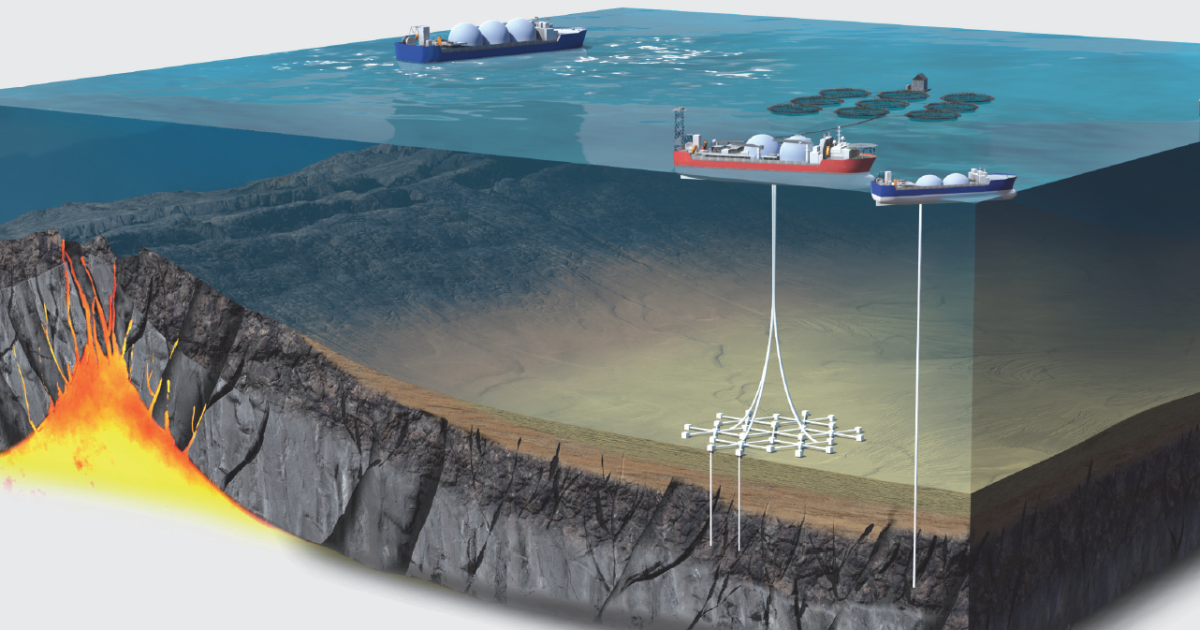A potentially game-changing and largely unexplored energy jackpot lies beneath the ocean floor, according to a whitepaper from geoscience tech consultancy CGG. Unique conditions under the sea bed promise cheaper and more accessible geothermal power.
Solar and wind can’t get us to a clean energy grid alone. Geothermal is a dream source of clean energy in many ways; the hot rocks under our feet hold more energy than humanity could use in a million years… Although just to be clear, that’s not a challenge… I’m looking at you, OpenAI and Bitcoin miners. Bring it up to the surface, and you can directly use the heat, or harvest electrical energy from it. The energy’s there 24/7, unlike solar and wind, the infrastructure costs aren’t terrible, and it’s available right underneath us, anywhere on the planet.
And yet, it represents less than 1% of global energy production, because while there are hot rocks somewhere under your feet wherever you’re standing, they’re much easier to get to in some places, where they’re closer to the surface, than in others, where they’re buried so deep they’re virtually impossible to get to economically. Well, at least until the particle beam drills are ready.
What’s more, geothermal exploration drilling is relatively expensive, and not always successful. So companies have tended to stick to areas they’re relatively sure will deliver – like the Indo-Pacific “Ring of Fire,” a tectonic belt that runs all the way up the West coast of the Americas, across to the Eastern tip of Russia, down through East Asia and across to cover New Zealand. Essentially, where there are volcanoes, the geothermal industry is getting better at developing them as energy resources.
But according to renewable energy tech consultancy CGG, these volcanic areas are quite complex and varied, requiring bespoke approaches to each one, and temperatures rapidly decrease as you move away from the volcano.
On the other hand, there’s a vast and much more consistent resource we could be targeting, says CGG, on the sea floor, right where the tectonic plates are constantly moving away from one another and generating new chunks of crust in a process called “seafloor spreading.”
Sea Floor Spreading
In these huge undersea rifts, which CGG estimates at around 65,000 square kilometers (25,000 square miles), the Earth’s magma is reliably quite close to the surface, because it’s literally pouring through the gap created as the plates move apart, and solidifying into new rock. Thus, success rates should be much higher than they are on land, and these seafloor spreading zones should also offer more consistent temperatures, as well as consistently benign geothermal fluids.
In short, they replicate the best conditions you might find onshore in places like southern Iceland – where volcanic emissions have piled up on top of a seafloor spreading ridge to make it accessible from the land – except the offshore resources are much, much bigger.
On the other hand, while these areas will be easier to plumb, they’re further away from electrical grids. Indeed, a lot of this energy will be generated in areas where it won’t be practical to run cables back to the shore. CGG says in many areas it’ll make more sense to capture fresh water from steam the runs up through the turbines, and electrolyze it to produce green hydrogen, which can be shipped as is or converted to ammonia for sale – with fresh water likely left over as another saleable by-product.
CGG has applied for a patent on its “novel combination of geological, geophysical and engineering technologies to help explore and develop these resources,” but the company states (for what it’s worth) that its “motivation for obtaining the patent is to ensure that there will be no patent “blockers” delaying rapid development of these resources.” It plans to license the idea at “reasonable cost” in developed countries and at “easily affordable cost” when working with underdeveloped countries.
It’s too early as yet to start talking about Levelized Cost of Energy (LCoE), we’d presume – the cost per unit of energy across the projected lifetime of a generation project. And indeed, if companies like Quaise manage to democratize ultra-deep particle beam drilling at mass scale, they might well unlock the potential of geothermal literally anywhere on the planet. But humanity needs unfathomable quantities of energy over the coming decades from clean sources, and offshore geothermal may well have a valuable contribution to make.
Source: CGG






